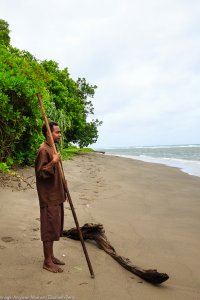The impacts of climate change can be surprisingly far-reaching, affecting families in unexpected and complex ways. Here, Tagolyn Kabekabe, the Anglican Alliance’s Pacific facilitator, talks about just some of those impacts, describing a chain of consequences that include a change in the types of diseases affecting communities.
The problem

Facing an uncertain future
The whole of the Pacific is affected by rising sea levels. It affects everybody, but it is worst for the low-lying islands. We’ve had incidences when a spring tide has washed through the islands – and it washes everything with it: the chickens, the pigs, it washes through the kitchen taking the pots, the pans, everything into the sea. These are things that people are now experiencing, which they say never happened in the past. They used to have high tides, but it was only half a meter – but that has changed so much in the last fifteen years.
When we have this rising sea level and unusual high tides and things like that, it actually destroys whatever crop is grown – not necessarily just along the beach or coastline, but it also affects inland. A lot of people plant swamp taro and swamp taro needs a certain salinity to be able to grow well and produce tubers. But when you have extra salt it disturbs the level of salinity – it becomes too salty and it affects the crop. It rots the tubers and in the long run it kills off everything. This affects not only the current harvest but also the ability of people to replant the following season. And the increased salinity not only affects swamp taro; things like bananas, bread fruit, even coconuts are affected by too much salt in the soil. So a certain level of salt is suitable for these plants but too much kills them.
Our rain fall patterns have changed too, in two major ways: one is that we don’t get the rains when we expect them and the second is that when we get the rain it‘s just too much – or maybe too little. The unusual rain pattern also affects crops. Too much rainwater disturbs the balance. So it’s both ways and these are things our people have no control over. We cannot control sea level rise, we cannot control how much rain falls onto the crops. Our people cannot protect themselves from these things and so the people simply go with what happens.
The impact
The adverse impact of these changes on people’s health is steadily increasing, especially amongst grassroots and rural communities living on lower lying islands.
Swamp taro is the staple food of these islanders. As swamp taro has declined due to increasing soil salinity the diet of the community has changed drastically. People start to depend on imported foods such as rice, flour, noodles, sugar, tea, and canned meat and fish. And for these, people are dependent on supply boats. There is a time known as the time of ‘hunger’ when the boats that bring the imported foods, medicines etc do not follow the monthly schedules and this is a very common occurrence, especially when it is not bêche-de-mer (sea cucumber) season. People then, for a month or more, eat only fish and coconuts, which greatly affects their diet and wellbeing – especially so young children. Malnutrition then becomes an ever-increasing issue amongst children, and under-nutrition amongst adults.
The change from a very traditional concentrated and nutritious diet to a foreign and less nutritious one has resulted in many problems for the islanders. Traditionally, our people are very healthy – but now we are seeing increased levels of obesity and non-communicable diseases. There is an increase in diabetes and high blood pressure – diseases that we did not know of in the past. These problems are further compounded by the lack of basic medicines, diagnostic equipment, technicians and qualified medical staff in rural areas, resulting in patients not knowing their statuses and so succumbing to disease. The fact that rural health facilities lack train nurses means referrals of patients is virtually non-existent and many people do not have the money to pay for the boat fares to Honiara because of their limited resources. In these situations, people die of treatable diseases in the islands.
The forced change in diet affects families in other ways too. For our very rural people who are subsistence farmers and who very much live off the land, it’s a struggle to be able to buy the rice, which means that what little crops they have, they have to sell, or, if they have children who are working in towns and cities, they depend on them. That is one of the patterns we are now experiencing – that our families who live in the villages now depend on the children who are working and earning money to actually supply the rice for them. And this puts a strain on our community.
